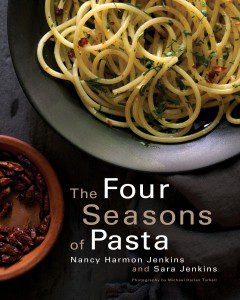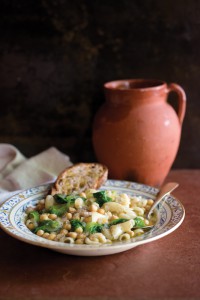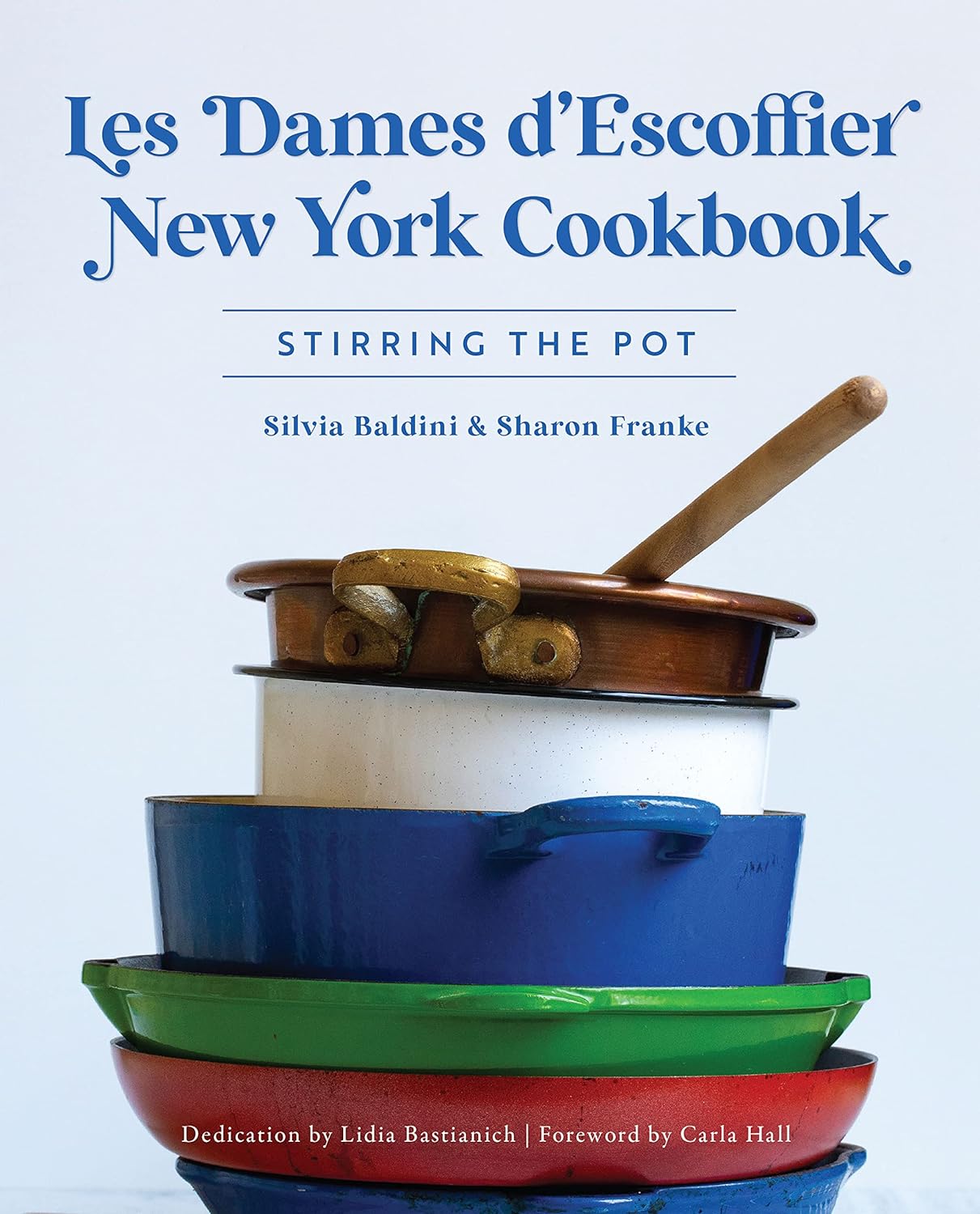Here’s a winter recipe from the new The Four Seasons of Pasta cookbook by mother and daughter team, Nancy Harmon Jenkins and Sara Jenkins using another of my favorite veggies, one that is under appreciated. I, too, like to pair it with a smoked pork product (I often use either bacon or salt pork) and pasta.
Nancy and Sara provide this for serving this dish “In old-fashioned country kitchens where this dish is a favorite, cooks often put in the bottom of each plate a slice of toasted country-style bread, rubbed with a cut garlic clove and with olive oil dribbled on top, before spooning the beans and pasta over it. Some cooks like to add a tablespoon of tomato paste dissolved in ¼ cup boiling water, stirring it into the chickpeas before the pasta and escarole are added.”
– bonnie
BonnieBOTB
Follow @BonnieBOTB
 Hearty bean and pasta dishes are welcome fare on cold winter nights. This one uses chickpeas (aka garbanzos or ceci). If you have a lot of small, mixed pasta shapes in your larder, it’s a great way to use them up. Otherwise, use cavatappi or a similar small, twisted shape. If you don’t have pancetta, bacon is fine to substitute. If you can’t find escarole, use spicy broccoli rabe (rapini), first trimming it of tough stems and slicing the leaves. In fact, almost any wintertime green does well in this dish. This is easily converted into a vegetarian dish simply by omitting the pancetta and adding another tablespoon of extra-virgin olive oil. Pasta and legume dishes are often served like a soup, in a deep bowl, and are generally quite a bit saucier than, for instance, a pasta with tomato sauce. Serve it with forks and spoons so that those who deem it a soup can spoon it up, and others can use their forks to mash the beans in the thick and tasty liquid.
Hearty bean and pasta dishes are welcome fare on cold winter nights. This one uses chickpeas (aka garbanzos or ceci). If you have a lot of small, mixed pasta shapes in your larder, it’s a great way to use them up. Otherwise, use cavatappi or a similar small, twisted shape. If you don’t have pancetta, bacon is fine to substitute. If you can’t find escarole, use spicy broccoli rabe (rapini), first trimming it of tough stems and slicing the leaves. In fact, almost any wintertime green does well in this dish. This is easily converted into a vegetarian dish simply by omitting the pancetta and adding another tablespoon of extra-virgin olive oil. Pasta and legume dishes are often served like a soup, in a deep bowl, and are generally quite a bit saucier than, for instance, a pasta with tomato sauce. Serve it with forks and spoons so that those who deem it a soup can spoon it up, and others can use their forks to mash the beans in the thick and tasty liquid.
Pasta with Chickpeas, Pancetta, Garlic, and Escarole
2 ounces diced pancetta, guanciale, or bacon (about 1/ 3 cup)
1 tablespoon extra-virgin olive oil
½ cup dried chickpeas, soaked overnight in plenty of water
1 small yellow onion, very coarsely chopped
1 garlic clove, crushed with the flat blade of a knife
1 bay leaf
1 fresh rosemary sprig
Sea salt and freshly ground black pepper
½ pound pasta (see headnote)
¾ to 1 pound escarole or spicy greens, rinsed and sliced into 1-inch ribbons
Extra-virgin olive oil for garnish
Freshly grated parmigiano-reggiano
Combine the pancetta and olive oil in the bottom of a saucepan large enough to hold the legumes. Set over medium heat and cook, stirring, until the pancetta has given up a lot of fat and started to brown.
Drain the chickpeas and add to the pancetta, along with the onion, garlic, bay leaf, and rosemary. Cover with boiling water to a depth of 1 inch. Set on the stove over medium heat. When the liquid is simmering once more, turn the heat down low, cover the pan, and cook until tender, 1 to 2 hours, depending on the age of the legumes.
Check the pan from time to time, adding more water if necessary; otherwise just let the chickpeas cook and soften. When the chickpeas are done and most of the cooking water has been absorbed, add salt to taste and plenty of pepper.
Remove and discard the bay leaf and rosemary. Bring a large pot of water to a rolling boil. Add a big spoonful of salt, then the pasta and escarole together. Cook until the pasta is al dente, 8 to 12 minutes, or even a bit longer. Using a slotted spoon, scoop out the pasta and escarole and transfer directly to the chickpeas. Now it’s time for you to judge—if you want a soup, add more of the pasta-escarole cooking water to the pan. If you want a dish to eat with a fork, let the spoonsful of pasta and escarole drip thoroughly before adding them to the chickpeas. Whatever you do, however, there should be a lot of moisture in the mixture at the end.
Serve in deep soup plates, previously warmed. Garnish each plate with a good dribble of olive oil and pass parmigiano to top the dish.
Makes 6 servings
Reprinted by arrangement with Avery Books, a member of Penguin Group (USA) LLC, A Penguin Random House Company. Copyright © Nancy Harmon Jenkins and Sara Jenkins, 2015.








Leave A Comment